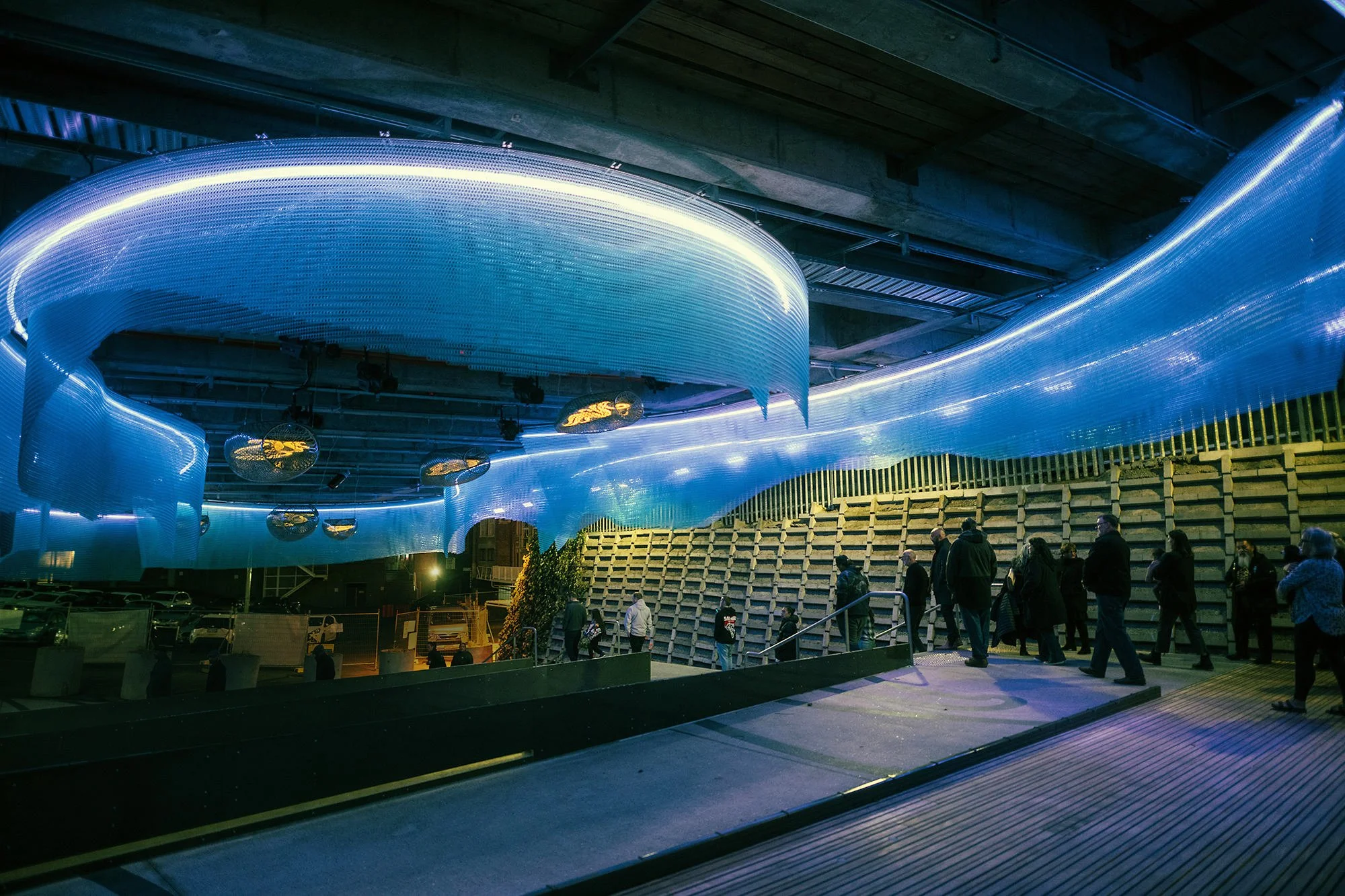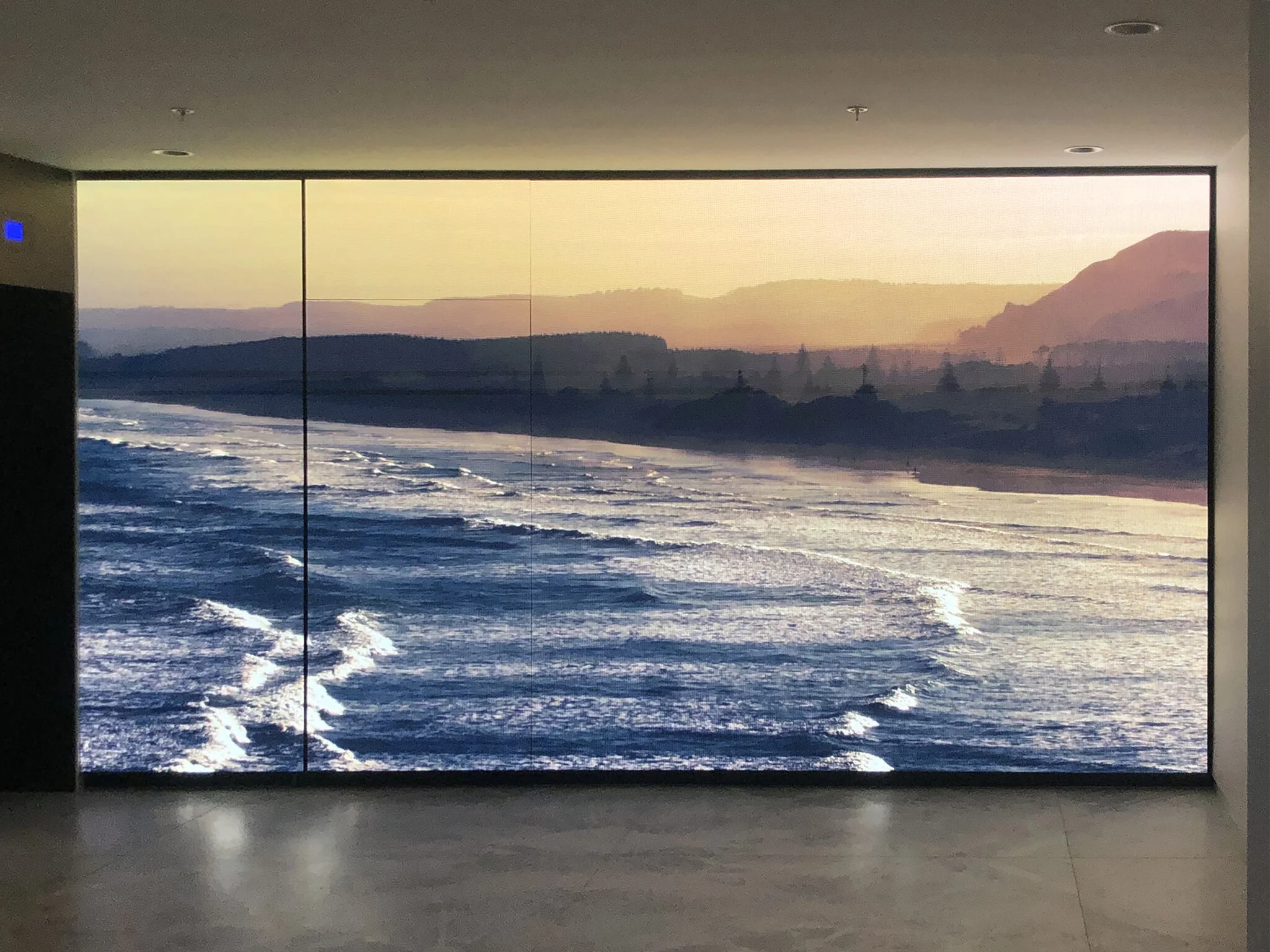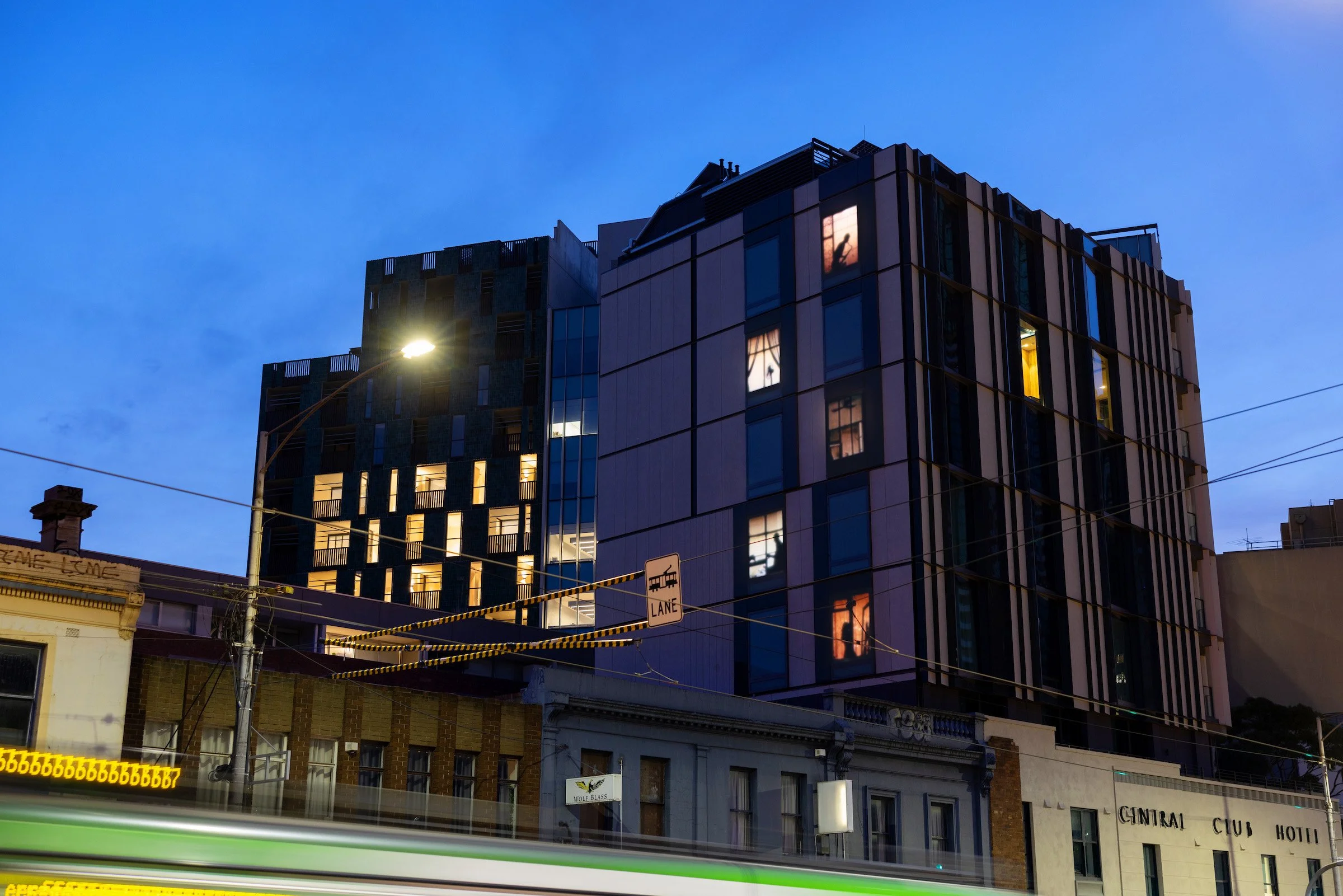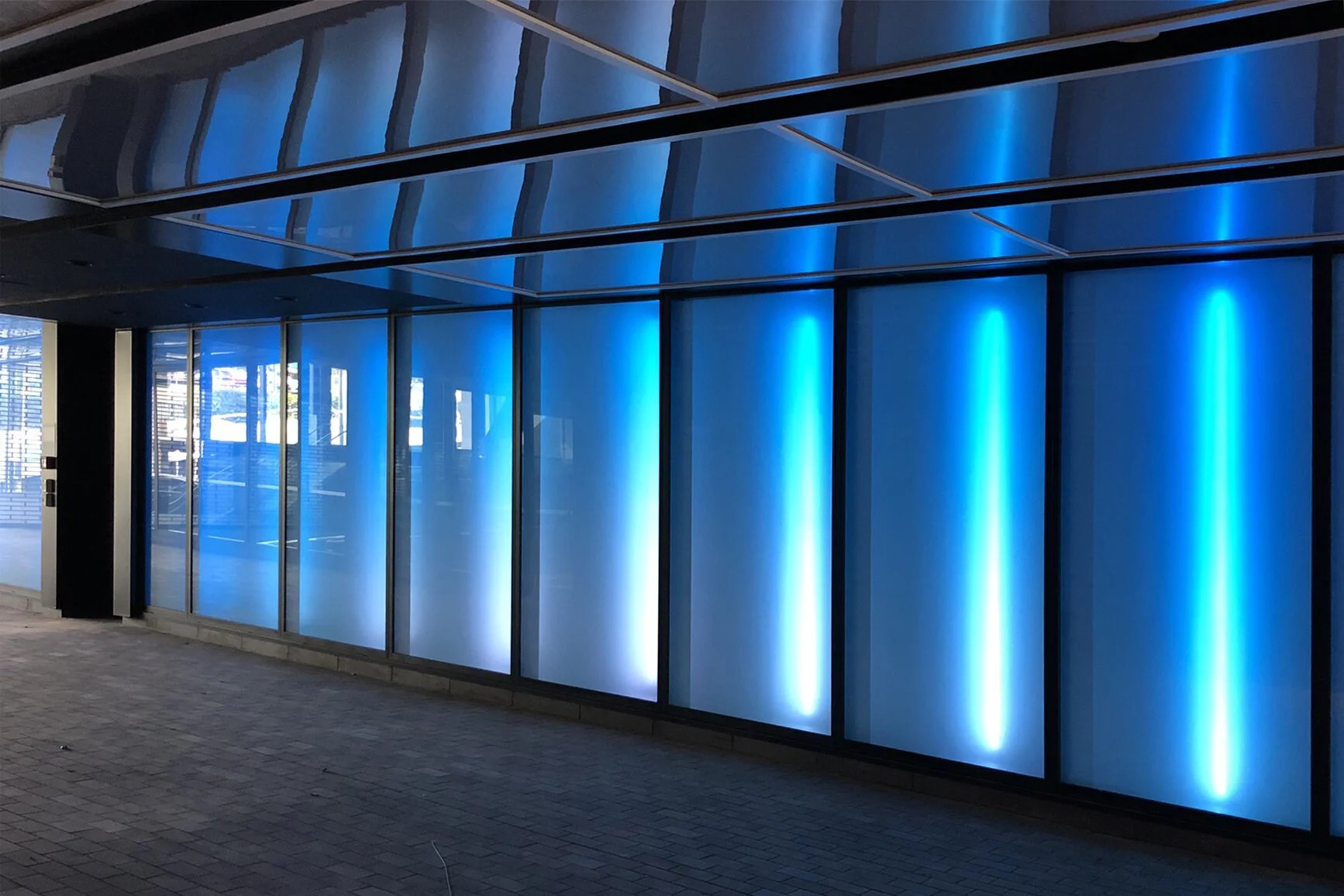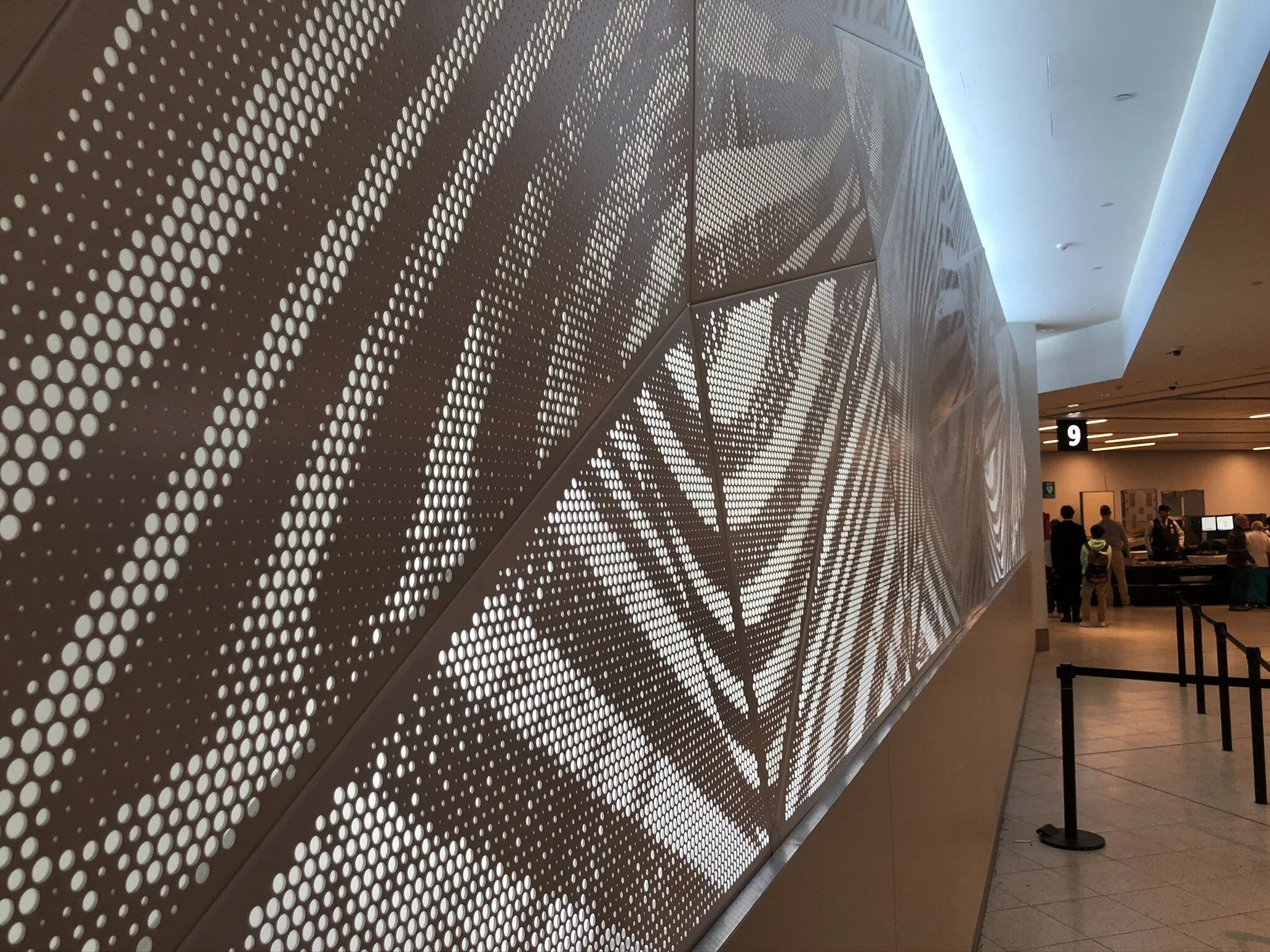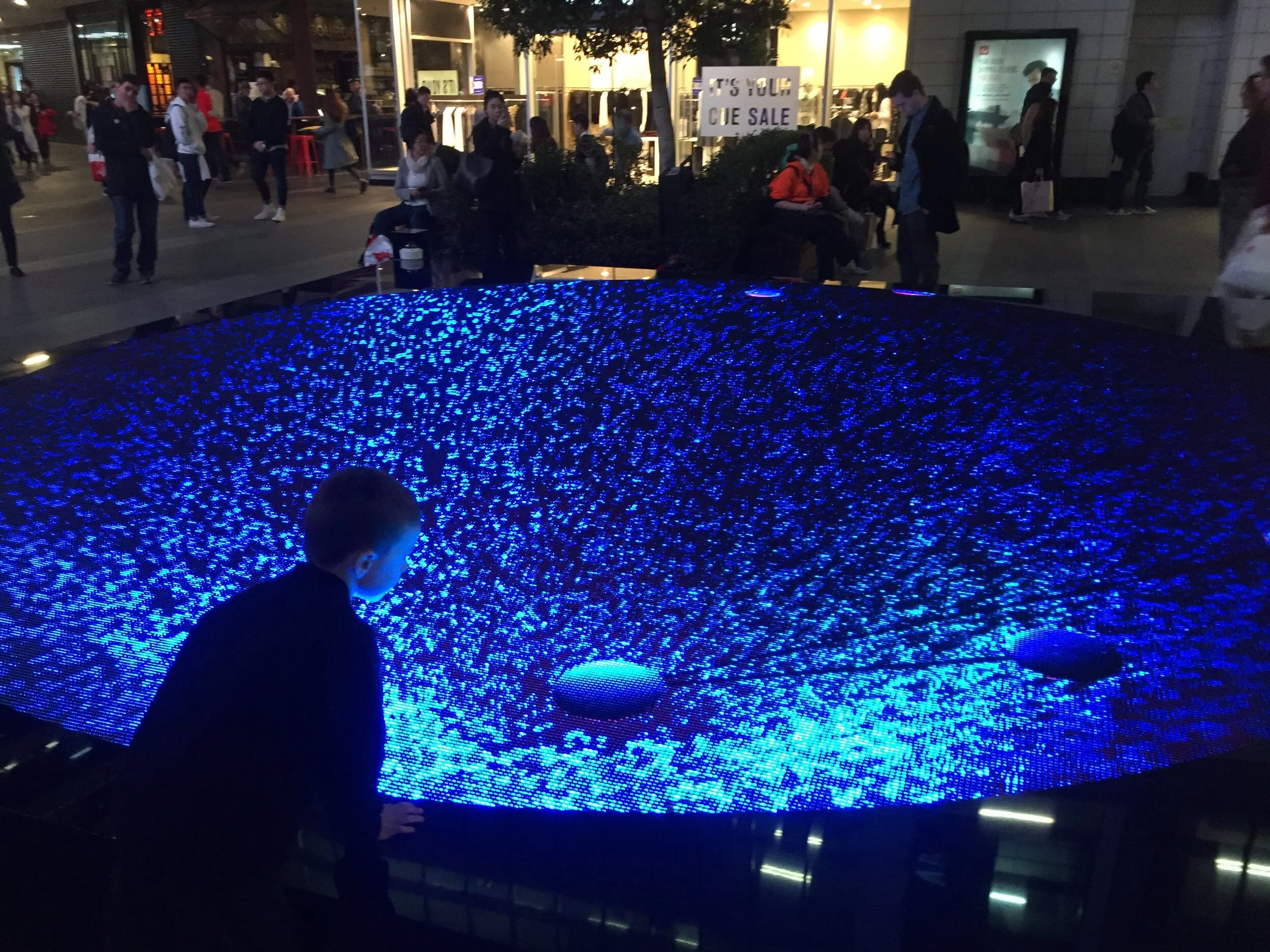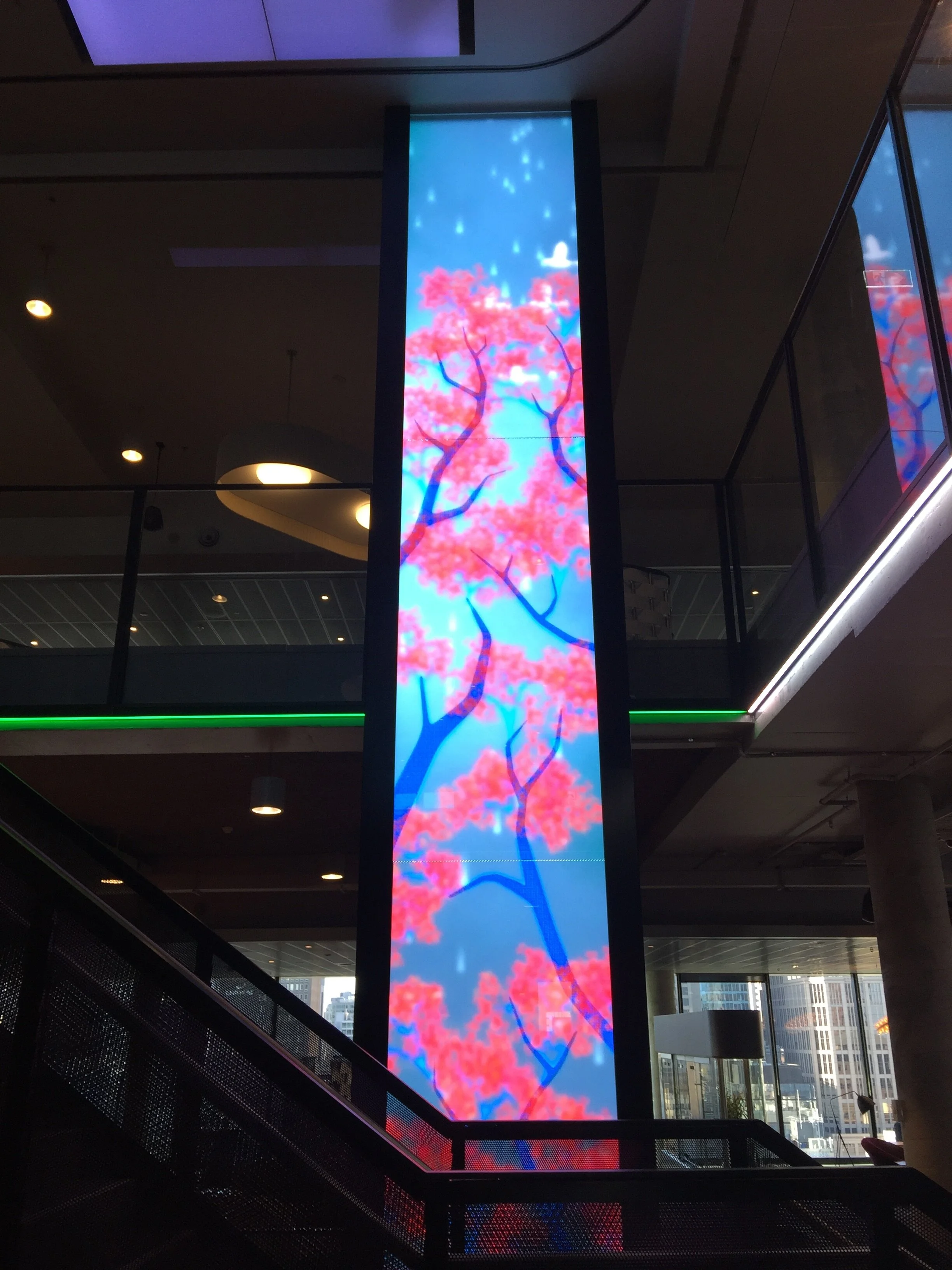Waimahara (Myers Park)
Client: Auckland Council (Public Art)
Lead Artist: Graham Tipene
Collaborating Artists: Moeahi Kerehoma, Tarumai-i-Tawhiti Kerehoma-Hoani, Tuirina Wehi, Justyn Pilbrow, David Thomas
Location: Auckland, New Zealand
Year: 2023
Waimahara, a captivating piece of art nestled within an underpass - gateway to Myers Park - transcends the ordinary, transforming a once dreary space into a mesmerizing oasis. As pedestrians venture through the underpass, they are met with the striking fusion of light and sound that breathes life into the surroundings. The gentle play of illumination dances upon the walls, casting ethereal patterns that seem to ripple like the surface of a tranquil river.
Yet, it is not just the visual spectacle that captivates passersby - an enveloping soundscape truly transports them to another realm. The soft murmur of flowing water and nature fills the air, evoking a sense of serenity and timelessness. Each drop, each bird call, echoes through the underpass, creating a harmonious chorus that resonates with the soul.
Immersed in this sensory experience, one cannot help but feel connected to the ancient river that still courses through this very spot (previously unseen, now revealed once again). Shadows seem to sway in rhythm with the cascading sounds of nature, mimicking the graceful movements of leaves stirred by a gentle breeze.
Waimahara serves as more than just an artwork; it is a testament to the transformative power of creativity. It breathes new life into forgotten spaces, revitalizing them with a sense of wonder and magic. In the heart of the city, amidst the hustle and bustle of urban life, this enchanting installation offers a moment of respite, a chance to pause and reconnect with the natural world that surrounds us.
Photo Credit (1): David St George
Wintjiri Wiru (Uluru)
Client: Ramus / Voyages Indigenous Tourism Australia
Location: Uluru, Northern Territory, Australia
Year: 2023
RAMUS designed and produced the drone, light, and sound show at Uluru in the heart of Australia. This immersive experience seamlessly blends cutting-edge technology with indigenous storytelling, creating a visually stunning and culturally impactful performance that captivates audiences from around the world.
CORE plays a pivotal role in ensuring the seamless operation of the daily performances. Integrated multimedia elements include choreographed drones, video projection and scanning lasers, multi-channel spatial audio, feature and house lighting - all sychronised and managed via an intuitive operator interface.
Given the harsh desert environment, CORE’s continuous autonomous monitoring and management of all show elements and their enclosures ensures successful ongoing operation.
Wintjiri Wiru Acknowledgement
As custodians of the land, Anangu hold the Mala story from Kaltukatjara to Uluru. To share their story, RAMUS designed and produced an artistic platform using drones, light and sound to create an immersive storytelling experience.
Viewing Platform Backlit Artwork Credit
Christine Brumby, Mala Story / Licensed by Copyright Agency 2022. We also encourage you to learn more about and share the story behind this artwork and Christine’s story.
Photo Credit (1, 4-6)
Photos by Getty Images for Voyages Indigenous Tourism Australia. Acknowledgement - Anangu share the Mala story, from Kaltukatjara to Uluru, through a drone, sound and light show designed and produced by RAMUS.
Magnitude (33 Federal)
Client: Bledisloe Property Group
Architect: Monk Mackenzie
Creative Director: David Hayes
Director of Photography: Josh Allen
Location: Auckland, New Zealand
Year: 2020
What if your daily commute involved a walk along Muriwai beach, beside cascading waterfalls at Karekare, beneath the tree-lined canopies of Cornwall Park, gazing out at the city from the Mt Eden summit, or flying high above waves crashing onto the West coast? For the tenants and visitors at 33 Federal, it does.
As part of extensive building renovations, a feature digital artwork was envisioned to vitalise and illuminate the refreshed entrance lobby. The glazed lobby enables 24-hour visibility of the prominently positioned artwork, defining the space and acting as an iconic attractor in accordance with the overall design by the architects (Monk Mackenzie).
The vision for the artwork is to bring light, depth, and nature to the space, seeking to explore and express the magnitude of these intertwined elements. We filmed and delivered over 30 hours of long-form cinematic content of Auckland's unique scenery, curated as an ever-changing environment, continuously colouring and reinterpreting the context of the space.
CORE compact was deployed to commission and control the installation. The scheduling and compositing features are used to overlay a digital tenant directory, shown during business hours.
Curiously, access to the bathroom and changing facilities through the feature wall had to be maintained, resulting in a unique LED wall that includes a concealed operable door.
Silhouettes (240 Victoria Street)
Client: Ramus / NSE Property Group
Architect: Bayley Ward
Screens: ULA
Location: Melbourne, Victoria, Australia
Year: 2023
At 240 Victoria Street, all is not what it seems. Nestled amidst Melbourne's bustling cityscape, Silhouettes offers a unique glimpse into the inner life and movement of the building, conveyed through an expressive digital media installation.
Digital windows on the facade of the building intermittently come alive as silhouetted figures engage in a myriad of activities, from the mundane to the extraordinary, creating a tapestry of human experience that unfolds before the eyes of those who happen to glance upward.
CORE with Sandbox enabled the iterative content commissioning process (including hybrid in-person/remote workflows), as well as the intermittent display of life and activity based on real-time occupancy metrics for the building.
Te Ara I Whiti / The Lightpath
Client: Auckland Council (Public Art)
Architect: Monk Mackenzie
Whakairo (Art Carving): Katz Maihi
Artist: David Hayes
Location: Auckland, New Zealand
Year: 2015
We were engaged to realise the vision of the architects, creating a dynamic responsive light artwork that went on to become an iconic part of the city of Auckland. We collaborated with Monk Mackenzie and Katz Maihi to incorporate their aesthetics and narrative into the artwork.
30 motion tracking cameras were installed, enabling the artwork to respond to presence and motion. Bespoke luminaries were designed to combine both a direct view and wash effect to be installed along the 700m length of the bridge. CORE Compact and a bespoke dynamic engine together control the installation.
Foundational content defines the character and personality of the iconic bridge, referencing the underlying narrative of a sleeping breathing taniwha that stirs when people move along its back.
Ongoing involvement involves a curatorial programme of collaboration with non-digital artists to bring their art to a new medium, as well as a content programme that considers how the artwork can respond to and be part of special events.
Intersection (1000 La Trobe)
Client: Ramus / POLY
Architect: Woods Bagot
Location: Melbourne, Victoria, Australia
Year: 2022
Architectural innovation intertwines with an intuitively responsive artwork at 1000 La Trobe. Intersection is a dynamic installation that seamlessly integrates art and technology, intuitively reflecting the ebb and flow of urban movement.
As day transitions into night and seasons change, so too does Intersection, evolving with the rhythm of the city. Its elegant design and technological framework enable real-time interaction with data streams, including public transit information. As trains and trams arrive and depart from nearby stations, Intersection responds with shimmering luminosity across the building facade.
Whether admired from afar or experienced up close, Intersection encapsulates the essence of Melbourne's bustling metropolis.
CORE with Sandbox was utilised to enable intuitive management of content responding to seasonal and PTV real-time data sources, with content delivered remotely during COVID-19 restrictions.
The Star Sydney
Client: Ramus / Star Entertainment Group
Aerialist: Couture Air / Julie Cameron
Interactive Artist: Reelize / Jobe Williams
Water Feature: Aquatique Show / Norbert Fischer, Thierry Sipp
Location: Sydney, NSW, Australia
Year: 2019
The challenge put forward by Ramus was three-fold: bring together numerous technical elements in a cohesive way to read as a singular artwork, create a show controller that allows tightly choreographed performances to run autonomously, and enable visitors to influence the large-scale installation in unexpected ways to surprise and delight.
The CORE system that was designed and deployed was the largest at the time. Three servers were installed that together control the 8K curved LED panel, linear video fixtures on walls and ceiling, projectors, laser, lighting rig, graphic water feature, audio, house lighting, and building management integration.
We developed an intuitive overall content canvas and layout modes that empowered content creators to easily include diverse outputs for all-encompassing pieces, and gave design direction during content commissioning to ensure capabilities of the installation were fully leveraged. We also provided technical management of the temporary Front of House position, enabling content creators to work efficiently in real-time with the various elements of the installation.
During design and commissioning, we continued to extend CORE's features to achieve more integrated show control, allowing a single system to run the entire show to timecode. Instead of needing a crew of operators we designed the system to run autonomously, a show could be triggered according to a schedule or with a single tap.
CORE Sandbox was installed along with two wide-angle tracking cameras to support a bespoke interactive artwork. We collaborated with the interactive artist to create a multi-faceted responsive experience that reacts to presence and momentum of people in the space as well as close up interaction.
After travelling to France to test the novel graphic water feature we were able to push the technology further, creating completely new effects to astound visitors. Although a new medium for us, our experience with temporal axis graphic algorithms was surprisingly applicable to the way the water feature worked.
It was a pleasure to collaborate with aerialist Julie Cameron and artistic director Bruce Ramus in realising his vision for two live performer shows, The Aqualume Grand Show and The Aqualume Lunar New Year Performance, fully integrating the content and technical elements with the aerialist's performance.
We also had the pleasure of delivering a unique activation, The GIFs of Christmas, a playful collage of ever-changing short colourful animations that filled the space.
Flow (Cowies Hill)
Client: Ramus / Wyndham City Council
Location: Melbourne, Victoria, Australia
Year: 2022
Cowies Hill is now home to an extraordinary sight: A mesmerizing projection-mapping installation adorning the iconic water tower, Flow, adds a touch of modern artistry, breathing life into the towering structure with a symphony of light and color.
The unique contours of the water tower create a canvas unlike any other. As dusk descends, the the tower becomes a dynamic display as vibrant projections cascade and swirl, transforming the structure into a captivating spectacle.
Content is carefully choreographed to evoke the essence of water – from gentle ripples to powerful torrents – creating an ever-changing symphony of light and motion.
CORE handles the real-time 3D projection mapping (including projector management and monitoring) and pixel mapping of supporting wash lighting fixtures, as well as the daily and seasonal content rhythms.
Content was created in house with a variety of techniques using high-resolution ultra-slow-motion camera setups.
A 1:10 scale prototype was built in our studio to assess projector placement and ensure projection mapping was accurate.
Light Pillars (Les Mills Lane)
Client: Les Mills / Tailor Inc
Architect: Warren and Mahoney
Artist: David Hayes
Location: Auckland, New Zealand
Year: 2019
Light Pillars, rare natural phenomena in which vertical beams of light appear to extend from light sources caused by the reflection of light from suspended ice crystals in the atmosphere. Observers traverse the length of the artwork as part of their daily journey – the space itself is a conduit, not a destination. The effect is subtle, natural yet unnatural, the pace is slow but purposeful. The palette is one of natural light, both warmth and coolness, ever-shifting through moments of vibrancy. The artwork is durational, following a circadian rhythm of night to sunrise, day to sunset, dusk to night.
We delivered a light artwork that activated and illuminated the laneway, where both location and scale had already been prescribed by the architects.
We used CORE to accurately map physical fixtures and deliver a durational content programme, and were able to make final adjustments on site using our content commissioning suite, leading to an artwork that is well situated in its context.
Te Hokinga Mahara / A Collection of Memories (Warkworth)
Client: Auckland Council (Public Art)
Artist: Hokimai Rosieur
Location: Warkworth, New Zealand
Year: 2023
"This expansive sound and light installation tells the story of Mahurangi, and the enduring presence of te tangata whenua iwi, Ngāti Manuhiri. The 16-minute composition plays at seven, eight and nine in the evening from late March to September and at eight and nine o’clock summertime."
The artwork stands as a poignant tribute to the rich tapestry of memories woven into the landscape surrounding the Mahurangi Harbour. Across the river from the township, specimen trees are bathed in gentle illumination, casting a luminous glow from dusk into darkness.
Periodically emerging from the ambient sounds of nature, the song unfolds, accompanied by choreographed light. Through this immersive experience, the artwork breathes life into the telling of a poignant and timeless story, inviting viewers to embark on a journey through time and culture, forging a profound connection to the land and its enduring legacy.
Photo Credit (1): David St George
Optus Stadium
Client: Ramus / BGIS
Location: Perth, WA, Australia
Year: 2017
The intention for the lighting design was to articulate the architecture and allow the stadium itself to become part of events; we wanted the stadium to have a unified visual expression – the video, lights and sports lights all sync to serve the moment.
- Bruce Ramus
Perth Stadium is an award-winning 60,000 seat venue designed to put fans first. The highest level of integration and co-ordination between technical elements was desired, as was a greater level of capability and expressiveness in content.
We installed CORE for multi-surface control of all creative lighting at the stadium. We mapped an unprecedented amount of fixtures and even managed to include the LED Sports Lighting system in the content map. We integrated with the venue's video playback system to create an incredibly responsive encompassing visual experience for sporting events, concerts and special events.
As a highly visible part of Perth’s skyline, CORE is used 365 days a year to dynamically illuminate the stadium.
At the time of commissioning it was one of the largest pixel mapped buildings in the world. Features include a striking halo with 634 powerful lensed wash fixtures, 891 individually dimmable LED sports lights, 85,000 pixels worth of linear fixtures around the entire facade, and a sculptural walkway illuminated by 672 coloured and white spotlights.
Still Light (80 Collins)
Client: Ramus / JLL
Location: Melbourne, VIC, Australia
Year: 2020
The architectural facade illumination at 80 Collins utilises a sparse distribution of fixtures on its geometric faceted facade to create a mesmerizing display of elegantly moving light.
The illumination transforms the building's exterior into a dynamic canvas that captivates both locals and visitors alike. Though the distribution of fixtures is sparse, strategic placement of lights and carefully considered bespoke content achieves a subtle yet impactful effect, while allowing the architectural features of 80 Collins to shine through, enhancing the building's unique geometry and architectural identity.
CORE accurately pixel maps the entire facade at the native resolution derived by the pixel pitch of the physical fixtures. Content is curated dynamically to form a continuous subtle illumination that rises and falls gracefully throughout each evening.
The laneways at the base of the tower are also illuminated with the subtle yet playful movement of shadows and light.
PHIVE / Parramatta Square
Client: Ramus / City of Parramatta
Location: Parramatta, NSW, Australia
Year: 2022
The media architecture installation at PHIVE in Parramatta Square is a multimedia experience designed to integrate seamlessly with the building's architecture.
It features a large-format digital screen situated in the foyer, complemented by supporting column screens both inside and outside the building. The building's facade/roof are adorned with an array of architectural light fittings, allowing for pixel-mapped content to dynamically alter the appearance and character of the building.
Intuitive content extension out into the surrounding space and across the building's exterior creates a cohesive visual narrative that engages viewers both inside and outside the building. The varying pixel pitches of the LED panels and the architectural lighting layout is easily managed by CORE’s real-time remapping engine with virtual canvas layouts for content creators.
CORE supports extensive flexibility that allows PHIVE to respond to community events and festivals, transforming the building into a dynamic canvas that reflects the spirit of the occasion.
Commercial Bay
Client: Fletcher Construction
Project Budget: $425 Million
Location: Auckland
Image Credit: Fletcher Construction
Completed with onSite
The Poles (Prahran Square)
Client: Ramus / City of Stonnington Council
Artistic Director: Bruce Ramus
Sound Designer: Material Thinking / Paul Carter, Christopher Williams
Interactive Designer: Reelize Studio / Jobe Williams
Location: Melbourne, VIC, Australia
Year: 2019
Ramus’ vision was for an artwork that would present many unique faces over time across the physical, visual, and audio elements.
The unique physical arrangement of poles within the square required an unconventional mapping approach. We used CORE to create a virtual canvas that enabled intuitive content creation within quadrants and across the entire site. Visitors see unique perspectives based on their location in the square.
The visual content set is augmented by a dynamic 3D simulated environment. We implemented the interactive designer’s piece on the CORE Sandbox and provided intuitive SDKs for computer vision camera tracking and real-time weather data as inputs.
Besides LED panels for the visual content, the poles each contain bespoke speakers to create atmospheric audio. The sound designers collected extensive recordings of local soundscapes, which our bespoke dynamic engine draws from to deliver millions of potential combinations across the 28 speaker-array.
Yagan Square
Client: Ramus / DevelopmentWA
Location: Perth, WA, Australia
Year: 2018
This large-scale project required synchronised multi-surface playback across high and low resolution outputs. The on-going content programme includes curated local films, digital art, commissioned bespoke works, interactive pieces, broadcast and commercial content.
Our solution was to implement CORE with multi-surface control, allowing co-ordinated control and content management across the entire site. Given the unique geometries of the outputs, rather then relying on content creators solving the same problems over and over, we created tools to shift content focal point around the cylindrical screen, remove seams in content, and extend high-resolution content onto low-resolution fixtures.
Knowing digital and non-digital artists, professional software developers, brand agencies, and student groups would be creating content for this unique public platform, we developed a detailed Software Development Kit (SDK) that would accelerate content production and enable a wide range of skill-levels to fully leverage the capabilities of the installation. The kit includes a rolling-rack mobile workstation, kept on-site to facilitate content creation.
This was the first project where we created a virtual low-resolution canvas on high-resolution outputs, cloaking the cylindrical screen by virtually extending the array of fixtures on the reeds.
We implemented incoming signal processing to conform a variety of live sources, enabling a variety of unique city-scale public experiences.
RWC 2011 Countdown Clock
Client: Auckland Council
Team: David Hayes, Jonathan Wiseman, Barrington Gohns, Fraser Horton
Fabrication: Precision Laser Cutting / Steve Caddle
Location: Auckland, New Zealand
Year: 2010
Our challenge was to design and implement an iconic countdown clock for the Rugby World Cup 2011, while keeping within strict time and budgetary constraints. It had to be unique, a landmark, an attractor, creating awareness and buzz for a full year leading up to kick-off.
As recent university graduates, four of us responded to the task. We collaborated and together won the Auckland Council tender by providing an innovative design that was far more ambitious than the competition. It ended up being the largest countdown clock in the world!
We designed and hand-built the circuit boards and electronics, and assembled the fabricated aluminium modules, finally commissioning them the night before the launch event. The project was completed within a tight 6-week deadline.
Fed Square
Client: Ramus / Fed Square
Location: Melbourne, VIC, Australia
Year: 2018
iion worked with Ramus on the physical design and control system, as well as content commissioning and dynamic/interactive content.
The scale of the building and desired pixel pitch meant the canvas resolution exceeded 4K. At the time this would normally have required more that one LED processor, as well as other compromises within the control system (especially balancing output quality with signal chain complexity and latency). We implemented CORE, making use of its powerful remapping features to generate a pixel-perfect virtual canvas and driving the entire facade through a single processor.
Knowing live sources would frequently be displayed on the facade, CORE's combined capture, playback, compositing, mapping, and output capabilities ensured video latency was minimised.
We consulted with content creators on the unique potential of this particular platform for the creation of dynamic artworks and interactive pieces, as well as working with local tertiary institutions to see student works successfully showcased on the big screen.
The Star Gold Coast
Client: Ramus / Star Entertainment Group
Location: Gold Coast, QLD, Australia
Year: 2016
We were offered the chance to help deliver two iconic artworks: the building facade and the entrance experience.
The facade projection is the result of 17 high-lumen projectors, 3D mapped and masked to the building’s balconies to avoid any light shining into hotel rooms. We integrated a media server with industry-leading projection mapping with CORE so that content could could be uploaded and scheduled without further technical assistance.
The entrance experience called for unique content mapping to make use of over 15,000 individually addressed LED nodes on living palm trees. Rather than resorting to 3D volumetric mapping and content, we saw an opportunity to create a 2D virtual canvas, enabling content creators to intuitively use the installation for far greater aesthetic possibilities. Our bespoke MNM computer vision mapping tool was used to create a pixel-perfect content map in minutes rather than days.
From the main entrance an observer sees an astonishingly legible image across the palm trees, where content appears to move through even the gaps between trees. From other angles the image becomes more abstract.
CORE provides real-time monitoring and alerts across the site, which is especially important for the environmental conditions and health status of the projectors and their enclosures.
NZICC
Client: Fletcher Construction
Project Budget: $700 million
Location: Auckland
Image Credit: Fletcher Construction
Under construction with onSite
Songket (PLQ)
Client: Ramus / LendLease
Location: Singapore
Year: 2019
An opportunity arose for Ramus to work with an existing client (Lendlease) on an new precinct under development in Singapore.
We established new relationships with local suppliers to deliver an integrated artwork in the outdoor plaza area of Paya Lebar Quarter.
Our experience in technical commissioning and content production was utilized to not only commission the CORE control system but to work with Ramus filming on location and refining content in a condensed timeframe.
ASB Classic
Client: BrandKnew
Location: Auckland, New Zealand
Year: 2020
We were tasked with "appifying" the ordering process at a large high-profile sporting event, streamlining the ordering experience through to fulfilment and providing a high level of customer satisfaction.
In collaboration with BrandKnew, we fully re-engineered the process, which resulted in the development of a slick end-user ordering app, support for multiple payment methods, back-end order management system, real-time monitoring, and reporting. The app was multi-platform, and integrated with a secure credit card gateway and smart EFTPOS terminals for payment. Back-of-house tablets and large-screen displays enabled managers to see the entire ordering process, giving them vital information to make decisions that optimised use of staff and other resources, while maximising customer satisfaction.
Vivid: River of Light
Client: Ramus / WestonWilliamson+Partners
Location: Sydney, NSW, Australia
Year: 2019
We collaborated with lighting specialists Ramus and architectural firm WestonWilliamson+Partners to deliver an artwork for Vivid Sydney 2019.
We knew there would be limited time to commission the system, so everything had to be pre-configured ready to run, and we enabled content creators in Sydney and Melbourne to work remotely to minimise time required on-site. In the end, the installation was ready only three hours after arriving at the site.
CORE allowed for remote monitoring and scheduling during the festival, and we provided remote support to on-site operators as needed.
Melbourne Airport T2
Client: Ramus / Melbourne Airport
Location: Melbourne, VIC, Australia
Year: 2019
Although small in scale, prominent placement in the departures area of the second busiest airport in Australia meant that carefully considered content and stable on-going operation were as important as ever. With construction completed, on-site commissioning in the fully operational security lounge was constrained to a single afternoon.
CORE Micro was deployed to facilitate rapid installation and content commissioning. CORE's content management platform allowed all content to be uploaded, ingested and scheduled in a single afternoon, benefitting from the same familiar workflows of larger installations.
Attention Seeker (World Square)
Client: Ramus
Location: Sydney, NSW, Australia
Year: 2018
We were tasked with developing an unexpected and novel interactive artwork for an already designed temporary installation in the middle of Sydney CBD. We delivered a digital version of 3D illusion sidewalk chalk drawings that reacted to people approaching and observing it, turning the digital display into a virtual window.
We installed a temporary self-contained CORE (as well as two tracking cameras) to run our bespoke artwork, as well as displaying two other works commissioned by Ramus for the installation.
Camp Glenorchy
Client: Pounamu Holdings
Building Automation: Evident / Shay Brazier
Location: Glenorchy, New Zealand
Year: 2018
Our brief was to create amenity lighting that was not only beautiful but also sympathetic to the natural environment and aligned with the energy conservation values of the client. We delivered highly localised lighting that gently illuminates the portion of the path where people are walking.
By integrating an array of sensors (installed as part of the Building Management System) and installing individually controllable linear LED, the light responds beautifully to the presence of people and brings an artistic quality to what could otherwise be rather utilitarian. Rather than treating sensors and lights as discrete units, we leverage granular dimming control of thousands of individual LEDs to create animated waves of light that move with people.
George Place
Client: Ramus / ISPT
Location: Sydney, NSW, Australia
Year: 2018
A challenge we regularly face is receiving accurate fixture mapping data. For this project we leveraged our MNM fixture mapping tool, using computer vision to automatically identify and accurately locate fixtures, producing a physically mapped content canvas.
CORE was installed to provide multi-surface support (ceilings, walls and revolving doors), allowing content to define the environment of the whole lobby space.
In installations where fixtures are sparsely installed across a wide area, spatial mapping allows for unique graphical algorithms that move through the canvas to articulate the architecture.
Synergy (Freshwater Place)
Client: Ramus
Animator/Illustrator: Pablo Tochez Anderson
Location: Melbourne, VIC, Australia
Year: 2018
Ramus envisioned a singular digital painting that would be durational and consistent but unrepeating. Rather than proposing an on-going real-time simulation, digital artist Pablo Tochez Anderson responded with a curated series of animations produced with finely tuned simulations, giving greater artistic control over the outcome.
We developed a bespoke dynamic engine that curates the combining of animations in response to time of day and local tide, as well as organic virtual camera movement that shifts focus dynamically across a scene that is larger than the physical canvas.
The result was an ever-changing artwork that was recognisable and familiar, but never the same.
Wavelength (Canterbury League Club)
Client: Ramus / Canterbury League Club
Location: Sydney, NSW, Australia
Year: 2018
The physical design raised questions around content legibility due to the high ratio of gaps to lighting fixture widths.
CORE Compact was utilised to accurately map the physical gaps in the content canvas. This enabled content to move accurately through the gaps where there were no fixtures, providing greater fluidity to moving content leading to even higher legibility that originally envisioned.
Darling Quarter Luminous
Client: Ramus / LendLease
Location: Sydney, NSW, Australia
Year: 2012
Darling Quarter Luminous was at launch the largest permanent interactive lighting installation in the world.
In collaboration with Ramus, our intention for this project was to allow people to interact with an entire building facade in a way that had previously been unthinkable.
To fulfil this vision we developed an entire interactive platform comprising several key elements:
- A website allowing users to design and submit their own light shows that are curated and scheduled to play out on the facade, as well as a live representation of the facade, connecting people who are not connected physically.
- Mobile apps that empower the public to use their phones to interact with the facade. Apps include familiar arcade-style games that can be played on the facade, as well as offering other new and exciting ways to interact. Fingerpaint is the most popular app, with an intuitive interface that allows users to draw with different colours in real-time directly on the facade.
- Two outdoor touch-screen kiosks are installed to allow visitors to use the interactive apps. This was especially important at launch as smart-phones were relatively new and rare.
Our solution also included a cloud-based controller, on-site interactive server, and infrastructure for playback and facade output capture. We implemented a queueing system to manage many simultaneous connections from smart phones and the on-site kiosks, with a matching system for multi-player interaction.
King and Phillip
Client: Ganellen
Project Budget: $110 million
Location: Sydney, CBD
Image Credit: Ganellen
Completed with onSite
Dream Bank
Client: BLAKE / Westpac
Creative Director: David Hayes
Graphic Designer: Rebecca Hand
Digital Consultant: Rohan Adarkar
Year: 2017
The Sir Peter Blake Trust Dream Team is a group of inspirational Kiwi leaders who every year aim to inspire thousands of Kiwi kids to follow their dreams. They visit schools to tell their stories, plant seeds of inspiration, and encourage young New Zealanders to have big dreams and back themselves to make them happen.
Our brief was to create a unique online experience for school aged children to meaningfully consider and share their dreams for themselves and New Zealand. In response, we developed an interactive website with a fun animated aesthetic that extended the reach of the Sir Peter Blake Trust Dream Team online.
This was achieved by creating a bespoke web platform designed with a robust secure submission framework ready for high-traffic. We developed a playful aesthetic and created an enormous number of graphic assets in-house. We also performed deep analysis of submissions to highlight themes, unique dreams, top submitting schools, and presented this information on the site in the Dream Vault as well as in widely used press releases.
161 Clarence
Client: Ramus / Crown Group
Animator/Illustrator: Pablo Tochez Anderson
Location: Sydney, NSW, Australia
Year: 2018
The interaction of passing pedestrians with public artworks is often fleeting. This installation seeks to capture attention and imagination through reflection - to glimpse oneself in another medium, the same but somehow different.
Real-time computer vision informs the installation of the presence and movement of people below, transposing scenes of otherness into the ordinary, transforming everyday into ethereal - a digital celestial sky that reaches beyond it’s physical bounds.
We incorporated multi-layer playback of artist-created video layers that combined to form a legible scene. Tracking data is fed into the engine to decide what layers to combine.
One example of an interactive scene is Underwater, with ripples as people enter and traverse the laneway, fish that gather near people, and a whale that swims the length of the installation when all is still.
USC Moreton Bay
Client: Ramus / University of Sunshine Coast
Location: Sunshine Coast, QLD, Australia
Year: 2020
For what would already be considered a complex project, completing the installation during a global pandemic added further challenges to be solved.
The installation spans the interior and exterior of a new university building across three distinct elements: High-resolution LED panel, high-resolution direct-view linear LED, and low-resolution LED wash. Rather than requiring multiple control systems, we used CORE to enable a singular expression and content creation methodology.
The layering of direct view and wash fixtures offered unique content opportunities, including developing a set of foreground and background pieces that could be combined to create numerous distinct looks.
A durational dynamic scene was also included in the content set proposed by Ramus, with real-time weather integration and cutting-edge graphics rendering. While a weather API is often sufficient, we chose to install a weather-station on the roof to get highly local real-time data.
To minimise the friction of working remotely (for both technical and creative people involved) we devised several innovative solutions, including using remote-controlled cameras as well as streaming previews from remote workstations to CORE on-site to emulate our normal iterative content commissioning methodology.
Stolen Girlfriends Club
Image Credit: Stolen Girlsfriends Club
Our show design and production expertise were called on for several Stolen Girlfriends Club runway shows in NZ and Australia.
"The show alone was amazing... it went out with a bang, staging a mock wedding with large poppers of confetti spraying out into the crowd as the model-bride threw her bouquet."
-Joanne Faith
Riverside Quay
Client: Ramus / Mirvac
Location: Melbourne, VIC, Australia
Year: 2018
In the midst of delivering some of our largest projects to date, we were challenged to provide the same rich content expressiveness for a smaller installation with a more limited budget.
We introduced CORE Micro, a low-cost single-surface control system. Moderating the output to a single surface meant we could scale-back hardware requirements while still providing all the benefits of CORE, from efficient content commissioning to intuitive cloud-based content management and monitoring.
Twin Towns
Client: Ramus / Twin Towns Services Club
Location: Tweed Heads, NSW, Australia
Year: 2018
This project presented a unique challenge where there were three distinctly different elements to control and integrate: two low-resolution lighting fixture types and a high-resolution LED video panel.
We implemented CORE to create a single canvas that enabled content to be expressed across the different fixture types. High-resolution content can easily be extended onto low-resolution nodes, and conversely a virtual low-resolution canvas can cloak the LED panel, giving the entire facade a low-res aesthetic.
CORE outputs video and lighting protocols, allowing a single piece of content to be mapped across the installation.
AUT Millennium
For almost a decade, iion has brought a breadth of expertise in technology and creative solutions to the sporting and human-performance environment at AUT Millennium.
Initially approached to assist with online presence, we became involved in overhauling the website and building an extensive multimedia catalog to better share the amazing activities happening at the facility. The website gives visibility to the wide range of business units and allows members and visitors to interact with them, as well as showcasing community involvement including water safety, health, nutrition, sporting education and achievement.
We developed a live Lane Availability display for the website, mobile devices, and on large-screen TVs within the facility, to give members a self-serve source of up-to-date information - it is the most visited page on the website.
We have developed two internal apps, AD Velocity and the Swim App.
We continue to provide consultation and expertise to develop and deliver on long-term technology goals that enhance and support member-first aspirations.
Enlighten White Night
Client: Ramus
Performers: Born In a Taxi
Location: Melbourne, VIC, Australia
Year: 2017
Ramus were collaborating with Born In a Taxi to develop an interactive festival show when they came to us with a unique challenge:
Because performers would interact with the audience in unpredictable ways, content cues could not rely on precise choreography. So, how could the live performance drive content dynamically?
We created several dynamic content scenes that reacted to performer movement resulting in a unique audience experience for each performance. Using a Kinect sensor to capture performers movements in real-time, the movement was then translated into our bespoke dynamic engine, which also followed the show controller scenes. The content was mapped to four sides of the cube that enclosed the performers.
Novotel Auckland Airport
Client: Warren and Mahoney
Project Budget: $65 million
Location: Auckland
Image Credit: Warren and Mahoney
Completed with onSite
Manukau Institute of Technology
Client: Hawkins Construction
Project Budget: $100 million
Location: Auckland
Image Credit: Hawkins Construction
Completed with onSite
Flame Tree (PWC Melbourne)
Client: Ramus / PwC
Animator/Illustrator: Pablo Tochez Anderson
Location: Melbourne, VIC, Australia
Year: 2018
The artistic intention from Ramus was to create a dynamic installation that would reflect the local context - seasons, weather, time of day - while maintaining a curated aesthetic.
In response, digital artist Pablo Tochez Anderson produced a volume of carefully crafted assets. We designed and implemented a bespoke dynamic engine that aggregated various real-time inputs and combined graphic assets to produce an ever-changing responsive scene.
The engine implemented seasonal colour schemes (for the 7 Kulin seasons), tree life-cycle (leaves, flowers, fruit), weather effects (rain, cloud, wind), day/night cycle with sunset/sunrise, and animated animals that appear according to a matrix comprising season, time of day, and weather.
AD Velocity
Client: AUT Millennium
Athlete Development is a world-leading research and development programme aimed at helping coaches, teachers and young athletes to be the best they can be.
The programme is about establishing fundamentals and focussing on a robust evidence base that will lead to rapid and sustained performance improvements. We put a purpose-built assessment tool in coaches hands that enabled them to measure performance and improvement over time as they coached.
Touchscreen interface elements are customised to the measurement being taken to maximise accuracy and efficiency. Measurements are normalised and weighted against the Academy’s five pillars of performance, giving an intuitive picture of athlete and group performance over time.
The app allow enables athletes to securely access their profiles, assessment results, coaching notes, and programme resources.
LIFE Conference
Jonathan and David have been involved in lighting and visuals at LIFE Conference and Sistas for over fifteen years.
Swim App
Client: AUT Millennium
With more than 2,500 students in over 500 weekly classes at 20 different skill levels, the AUT Millennium Swim School needed help with assessments.
We collaborated with teachers understand and develop a robust and efficient platform. Assessments needed to clearly answer the question of whether a student was ready to advance to the next level, and to help identify students that needed extra attention between assessments.
The custom-built app is installed on dozens of touchscreen devices in waterproof cases so that teachers can be poolside or in the water. Assessment results are automatically emailed to parents/caregivers to keep them informed, saving thousands of pages of paper.
Hello Auckland
boatiesnz
Client: McLaren Brown Publishing
Year: 2017
Together with McLaren Brown Publishing, we created an app and website for boaties in New Zealand. We built a modern and maintainable multi-platform app and responsive website with unique styling and features that also presented useful information from commercial partners.
To deliver the best solution for our client, we leveraged their existing custom CMS as well as providing enhancements and improvements. Xamarin was chosen as the cross-platform framework to streamline development. We worked with the client's in-house graphic designers to ensure styling of the app and website was on-brand.
VRx
We were tasked to demonstrate a commercial application of next-generation Virtual Reality technology to the architecture and property sectors. We created a turn key hardware/software platform and proved it on several projects.
The HTC Vive (and later Vive Pro) was identified as the most suitable platform as it allowed the user to physically move around the space, powered by high-end workstation processing and graphics to achieve the highest quality result. We used Unreal Engine to develop an intuitive VR user interface within a highly realistic virtual environment. We also created the VRx Cube, an all-in-one VR kit that protects the equipment when not in use and during transport.
VRx offered a turn-key VR solution at a time when others were still bringing arms’ full of prototype components.

